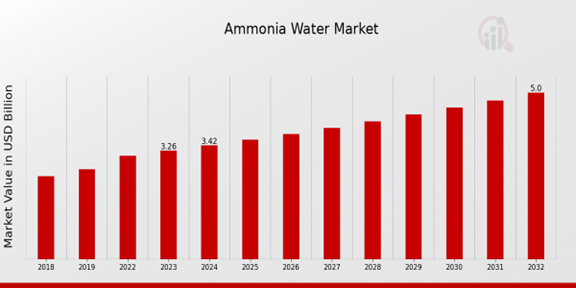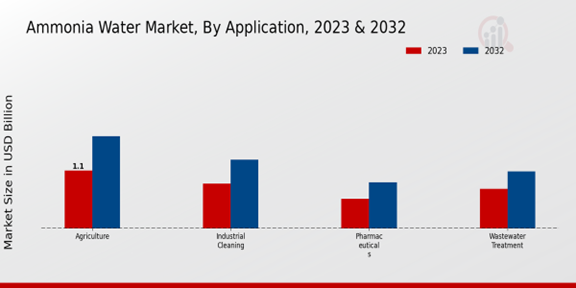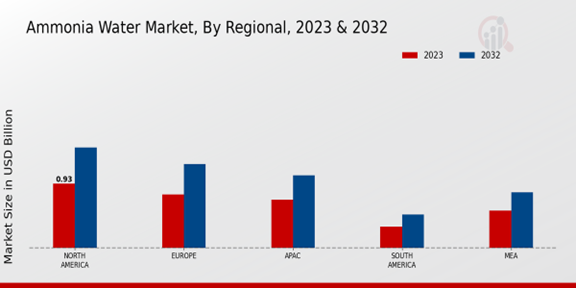Global Ammonia Water Market Overview
The Ammonia Water Market Size was estimated at 3.59 (USD Billion) in 2024. The Ammonia Water Industry is expected to grow from 3.76 (USD Billion) in 2025 to 5.76 (USD Billion) by 2034. The Ammonia Water Market CAGR (growth rate) is expected to be around 4.9% during the forecast period (2025 - 2034).
Key Ammonia Water Market Trends Highlighted
The ammonia water market is experiencing notable growth, driven by increasing demand from various industries, particularly in agriculture and chemical manufacturing. The rise in agricultural activities has led to a higher need for fertilizers, which often use ammonia as a key ingredient. Additionally, the chemical industry employs ammonia water for various applications, including cleaning agents and refrigeration processes. Growing awareness of the benefits of ammonia in promoting plant growth is further propelling its market demand. Environmental regulations and sustainability efforts are also encouraging the use of ammonia as a cleaner alternative in many applications.In this evolving landscape, there are numerous opportunities to be captured. Companies can focus on developing innovative formulations and eco-friendly products that meet the growing consumer demand for sustainable and effective solutions. Expanding into emerging markets where agricultural practices are evolving could provide significant growth avenues. Collaborations with agricultural firms or research institutions can enhance product development and offer cutting-edge solutions tailored to current agricultural challenges. Investing in technology to improve production processes and reduce costs will also create competitive advantages, especially as sustainability becomes increasingly prioritized.Recent trends show a shift toward more sustainable practices within the ammonia water market. There is a growing emphasis on reducing environmental impact, leading to innovations aimed at minimizing ammonia emissions during production. Companies are exploring ways to enhance the efficiency of ammonia use in farming and industrial processes, thus aligning with climate goals. Additionally, the market is witnessing a rise in partnerships and alliances aimed at advancing research and development efforts for ammonia-based products. These trends reflect a broader commitment to sustainability and highlight the importance of adapting to changing market needs while meeting regulatory requirements.

Source: Primary Research, Secondary Research, MRFR Database and Analyst Review
Ammonia Water Market Drivers
Rising Demand for Fertilizers
The increasing population and the corresponding growth in the agricultural sector are major drivers for the Ammonia Water Market Industry. Ammonia water plays a critical role as a nitrogen source in fertilizers, which are essential for enhancing crop yields and ensuring food security. With the agricultural sector expanding to meet the growing food demand, the requirement for ammonia-based fertilizers has surged. According to estimates, the agricultural output needs to increase significantly over the next decade, leading to higher consumption of ammonia and its derivatives in various regions, particularly in developing countries.Furthermore, the trend towards sustainable farming practices is pushing farmers to adopt fertilizers that enhance soil health while minimizing environmental impact. This rise in sustainable agriculture practices opens up new opportunities for ammonia water, as it is considered a safe and effective solution for nutrient delivery. As a result, this demand for fertilizers made from ammonia water is anticipated to drive the overall growth of the Ammonia Water Market Industry over the coming years.
Industrial Applications and Growth
Ammonia water is increasingly being utilized across various industries, including textiles, pharmaceuticals, and cleaning products. The versatility of ammonia water as a solvent and as a cleaning agent enhances its adoption in different industrial applications. Moreover, the rising trend of industrial automation and the need for efficient cleaning solutions are pushing industries towards utilizing ammonia water-based products, further propelling the Ammonia Water Market Industry.As industries expand and demand robust cleaning procedures, the role of ammonia water becomes more critical.
Environmental Regulations and Sustainable Practices
Increasing awareness regarding environmental sustainability and stringent regulations concerning chemical use are influencing the Ammonia Water Market Industry. Ammonia water is perceived as a relatively low-impact alternative to more harmful chemicals used in various applications, including manufacturing and cleaning. Consequently, more companies are seeking sustainable solutions, which enhances the market potential for ammonia water in industrial and agricultural applications, driving its growth.
Ammonia Water Market Segment Insights
Ammonia Water Market Application Insights
The Ammonia Water Market revenue demonstrates notable performance within various applications, with a predicted value of 3.26 USD Billion in 2023 and a growth trend expected to propel it to 5.0 USD Billion by 2032. This market's segmentation reveals key applications, notably in Agriculture, Industrial Cleaning, Pharmaceuticals, and Wastewater Treatment. The Agriculture segment commands a significant market share, valued at 1.1 USD Billion in 2023 and projected to rise to 1.75 USD Billion in 2032. This application is critical as ammonia water serves as a vital nutrient solution, enhancing soil quality and promoting crop growth, making it an essential component in agricultural practices.In the Industrial Cleaning sector, the market is also substantial, with an initial valuation of 0.85 USD Billion in 2023, expected to grow to 1.3 USD Billion by 2032. Ammonia water is recognized for its effectiveness as a cleaning agent, facilitating the removal of grease and grime in various industrial processes, which positions it as an integral resource for maintaining hygiene and equipment efficiency. The Pharmaceuticals application, valued at 0.56 USD Billion in 2023, is projected to expand to 0.87 USD Billion by 2032. In this context, ammonia water plays an essential role in the synthesis of pharmaceutical compounds, highlighting its significance in the production and development of medication and healthcare solutions.The Wastewater Treatment application holds a notable valuation of 0.75 USD Billion in 2023, which is set to rise to 1.08 USD Billion by 2032. This segment is critical as ammonia water aids in the treatment of wastewater by promoting the removal of nitrogen, thereby reducing pollution levels and enabling the recycling of water for safe usage. This application underlines a growing trend towards sustainable practices and environmental protection, driving demand in the Ammonia Water Market. As the industry expands, factors such as increasing agricultural needs, heightened focus on industrial cleanliness, and rising environmental regulations positively influence growth across these applications. However, challenges like handling ammonia-related hazards and regulatory compliance remain at the forefront for stakeholders. Opportunities in innovating safer handling and alternative formulations of ammonia water are critical to addressing these issues while maintaining growth in this diverse market sector. Overall, the Ammonia Water Market statistics signify a robust landscape poised for advancement across its diverse applications, driven by rising demand and technological innovations within the industry.

Source: Primary Research, Secondary Research, MRFR Database and Analyst Review
Ammonia Water Market Concentration Level Insights
The Ammonia Water Market, valued at approximately 3.26 USD Billion in 2023, demonstrates a notable segmentation based on Concentration Level, which includes Low, Medium, and High Concentration categories. Each concentration level plays a vital role in various industrial applications, thus impacting market dynamics substantially. Low Concentration ammonia water is often preferred in household cleaning products and agricultural usages due to its lower toxicity and environmental impact. Meanwhile, Medium Concentration finds significant traction in sectors like food processing and metal cleaning, balancing efficacy and safety.High Concentration ammonia water, while less common for everyday use, is crucial in industrial applications like refrigeration and chemical manufacturing, where strong chemical properties are necessary. The Ammonia Water Market revenue reflects diverse demand across these segments, driven by increasing industrial activities and the need for cleaning and sanitizing solutions. Factors such as regulatory environments, environmental impacts, and advances in manufacturing technologies pose challenges that the market must address while presenting opportunities for growth and innovation within these concentration categories.The projected growth of the market emphasizes the importance of understanding these segments to develop strategies for effective market penetration and product offerings.
Ammonia Water Market Distribution Channel Insights
The Distribution Channel segment of the Ammonia Water Market plays a critical role in delivering products to end-users, impacting the overall market dynamics significantly. In 2023, the market stood at a valuation of 3.26 USD Billion, showcasing the growing demand for ammonia water across various industries. Within the distribution landscape, Direct Sales represents a substantial approach as it allows for personalized customer interactions and immediate feedback, enhancing customer satisfaction. Online Sales are emerging strongly, benefiting from the convenience of digital transactions and the increasing adoption of e-commerce platforms, catering to a more tech-savvy audience.Wholesale Distribution dominates the channel due to its efficiency in bulk supply and cost-effectiveness, supporting various manufacturing sectors that require ammonia water as a key input. The Ammonia Water Market revenue is driven by these distribution modes, with each channel contributing uniquely to market growth while reflecting trends in consumer preferences and logistical advancements. The growth drivers, such as urbanization and industrial expansion, further fuel the demand across these channels, offering substantial opportunities for market players to expand their reach and optimize supply chains.
Ammonia Water Market End Use Insights
The Ammonia Water Market is witnessing notable growth, particularly within the End Use segment, which encompasses diverse applications, including the agricultural sector, chemical manufacturing, and food processing. As of 2023, the market is valued at 3.26 billion, reflecting the increasing demand across various industries. The agricultural sector plays a pivotal role, utilizing ammonia water as a fertilizer to enhance crop yield, thereby supporting the food supply. Chemical manufacturing is another significant domain, where ammonia water serves as a vital ingredient in producing a plethora of chemicals, highlighting its essential nature in industrial processes.Additionally, in food processing, ammonia water is utilized for refrigeration and cleaning purposes, ensuring food safety and quality. The growth within these areas is driven by the rising population and the subsequent need for efficient food production and processing. Market trends show an increasing awareness of the benefits of ammonia water alongside challenges such as environmental regulations and safety concerns that must be addressed. Overall, the segmentation of the Ammonia Water Market reflects a diversified landscape with substantial demand in key industries, supported by evolving market dynamics and opportunities for innovation.
Ammonia Water Market Regional Insights
The Ammonia Water Market is poised for growth, with a market valuation of 3.26 USD Billion in 2023. The regional breakdown reveals varying degrees of market presence, with North America leading as the most significant segment, valued at 0.931 USD Billion and expanding to 1.452 USD Billion by 2032, which illustrates its majority holding in the market. Europe, with a valuation of 0.776 USD Billion in 2023 and projected growth to 1.21 USD Billion, is significant due to its robust chemical industry that drives demand for ammonia water. The APAC region, although starting from a lower valuation of 0.699 USD Billion in 2023, shows considerable promise with expected growth to 1.048 USD Billion, driven by burgeoning industrial activities.South America and MEA, valued at 0.31 USD Billion and 0.543 USD Billion, respectively, in 2023, represent smaller yet expanding markets with potential for growth due to increasing awareness of ammonia's applications. Overall, the Ammonia Water Market statistics reflect a diverse landscape, with North America and Europe showing dominant positions while APAC demonstrates rapid market growth opportunities.

Source: Primary Research, Secondary Research, MRFR Database and Analyst Review
Ammonia Water Market Key Players and Competitive Insights
The Ammonia Water Market is characterized by its diverse applications and robust demand across various industries, including agriculture, pharmaceuticals, and chemical manufacturing. The market has seen significant growth due to increasing agricultural activities and the growing use of ammonia solutions in water treatment processes. As businesses focus on sustainable practices, the competitive landscape is becoming increasingly dynamic, with several key players actively vying for market share. Companies are continuously investing in research and development to innovate and improve product efficiency and sustainability. This competitive environment highlights the need for companies to differentiate themselves through operational excellence, product quality, and customer service to capture a larger segment of the market.Acron is a well-established player in the Ammonia Water Market, recognized for its strong production capabilities and extensive distribution network. The company capitalizes on its various strengths, such as a commitment to high-quality products that meet stringent safety and environmental standards. Acron’s strategic investments in technology enhancement and process optimization enable it to offer competitive prices while ensuring reliability in supply. Furthermore, the company’s established relationships with key stakeholders in multiple sectors bolster its market presence and foster customer loyalty, allowing Acron to maintain a significant foothold within the market.BASF stands out in the Ammonia Water Market through its impressive product portfolio and innovative approaches. The company leverages its advanced research and development capabilities to create efficient formulations that cater to the evolving needs of its clientele. BASF’s commitment to sustainability sets it apart, as it actively focuses on reducing environmental impact while enhancing product performance. This commitment serves not only to fulfill regulatory requirements but also to resonate with environmentally-conscious customers. Additionally, BASF’s operational presence enables it to meet diverse regional demands effectively, solidifying its position as a leading force in the ammonia water sector. Overall, BASF's strengths in innovation, sustainability, and customer relations contribute to its success and agility in navigating the competitive landscape of the market.
Key Companies in the Ammonia Water Market Include
- Acron
- BASF
- Koch Industries
- Nutrien
- Dyno Nobel
- Chambal Fertilisers
- KBR
- Mosaic Company
- Jiangsu Huachang Chemical
- CF Industries
- Yara International
- OCI Nitrogen
- Air Products
- Linde
- Green Plains
Ammonia Water Market Industry Developments
Recent developments in the Ammonia Water Market have seen significant attention, especially among key players such as Acron, BASF, and Koch Industries. These companies are actively engaging in sustainability initiatives, aiming to reduce ammonia emissions and improve the overall efficiency of ammonia production processes. Current affairs indicate that Nutrien and Yara International are focusing on enhancing their partnerships to promote green ammonia technologies, which are gaining traction due to the increasing environmental regulations worldwide. Additionally, recent market trends point towards the consolidation phase, with companies such as CF Industries and OCI Nitrogen exploring strategic mergers and acquisitions to strengthen their market positions and expand their production capabilities. Dyno Nobel is also increasing its investments in research and development to innovate ammonia solutions, while Linde and Air Products are collaborating on projects to optimize ammonia handling and distribution. The growth in market valuation for these companies is notable, which reflects an upward trend in demand for ammonia water, fueled by its applications in agriculture and industrial processes. This growth is expected to impact supply chains and create competitive advantages in the marketplace.
Ammonia Water Market Segmentation Insights
Ammonia Water Market Application Outlook
- Agriculture
- Industrial Cleaning
- Pharmaceuticals
- Wastewater Treatment
Ammonia Water Market Concentration Level Outlook
- Low Concentration
- Medium Concentration
- High Concentration
Ammonia Water Market Distribution Channel Outlook
- Direct Sales
- Online Sales
- Wholesale Distribution
Ammonia Water Market End Use Outlook
- Agricultural Sector
- Chemical Manufacturing
- Food Processing
Ammonia Water Market Regional Outlook
- North America
- Europe
- South America
- Asia Pacific
- Middle East and Africa
| Report Attribute/Metric |
Details |
| Market Size 2024 |
3.59 (USD Billion) |
| Market Size 2025 |
3.76 (USD Billion) |
| Market Size 2034 |
5.76 (USD Billion) |
| Compound Annual Growth Rate (CAGR) |
4.9% (2025 - 2034) |
| Report Coverage |
Revenue Forecast, Competitive Landscape, Growth Factors, and Trends |
| Base Year |
2024 |
| Market Forecast Period |
2025 - 2034 |
| Historical Data |
2020 - 2024 |
| Market Forecast Units |
USD Billion |
| Key Companies Profiled |
Acron, BASF, Koch Industries, Nutrien, Dyno Nobel, Chambal Fertilisers, KBR, Mosaic Company, Jiangsu Huachang Chemical, CF Industries, Yara International, OCI Nitrogen, Air Products, Linde, Green Plains |
| Segments Covered |
Application, Concentration Level, Distribution Channel, End Use, Regional |
| Key Market Opportunities |
Rising demand in agriculture, Expansion in pharmaceuticals industry, Growth in water treatment technologies, Eco-friendly product innovations, Increasing industrial applications |
| Key Market Dynamics |
Increasing industrial demand, Environmental regulations, Technological advancements, Price volatility, Supply chain disruptions |
| Countries Covered |
North America, Europe, APAC, South America, MEA |
Frequently Asked Questions (FAQ) :
In 2024, the Ammonia Water Market is valued at 3.59 USD Billion.
By 2034, the Ammonia Water Market is expected to grow to 5.76 USD Billion.
The Ammonia Water Market is anticipated to have a CAGR of 4.9% during the forecast period from 2025 to 2034.
North America is projected to have a significant market value of 1.452 USD Billion by 2034.
The agriculture application is estimated to reach 1.75 USD Billion by 2034.
Major players include Acron, BASF, Koch Industries, Nutrien, and Dyno Nobel.
The industrial cleaning application is projected to grow to 1.3 USD Billion by 2034.
The pharmaceuticals application is valued at 0.56 USD Billion in 2024.
The wastewater treatment application is anticipated to reach 1.08 USD Billion by 2034.
The market is expected to face challenges while also benefiting from emerging trends and growth drivers, particularly in the agricultural and industrial sectors.

















